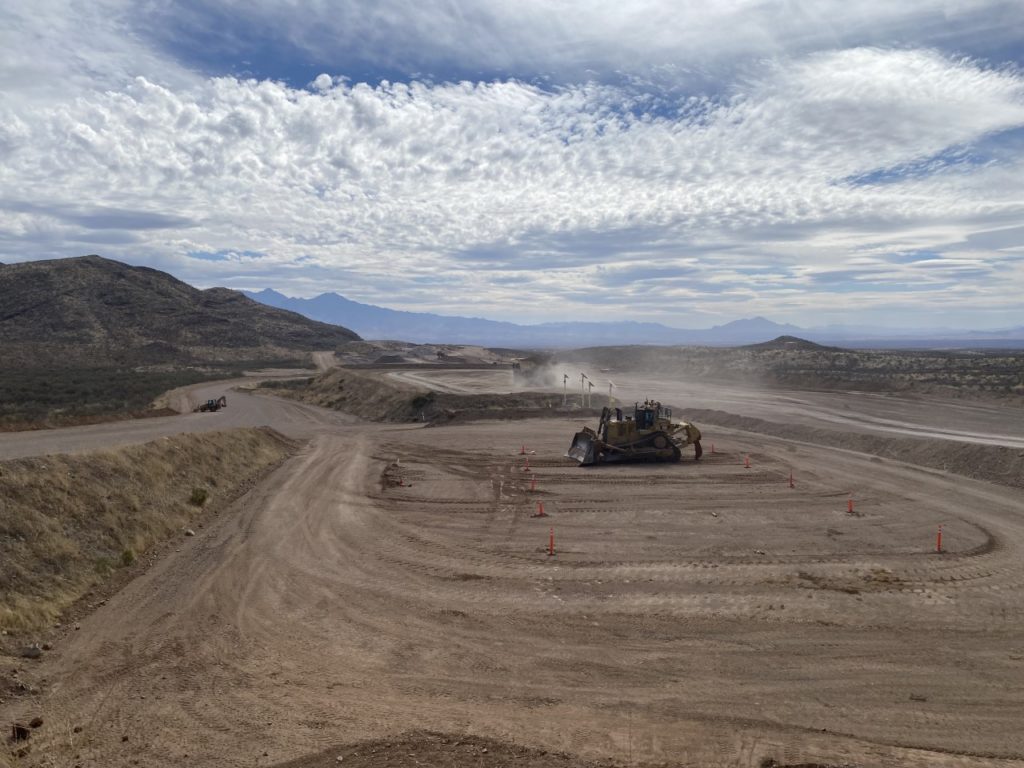Autonomy for mobile mining fleets is anything but a fixed or set system – it is constantly evolving with technology upgrades and functionality additions. Caterpillar Inc. through its Site 17 facility at its Tucson Proving Ground typically puts out on average two software updates for its Command for hauling system every year – ensuring that its mining customers have access to the best that autonomy can offer. International Mining Editorial Director Paul Moore recently had the privilege to visit the facility that is normally off limits except to some dealers and customer delegations. It gave a unique insight into the depth of R&D that goes into Command for hauling – which arguably explains why the company has autonomously hauled more than 4 billion tonnes, and the rate of autonomously hauled tonnes is accelerating as existing mine users expand their autonomous fleets plus new mines take their fleets autonomous. Over 1.2 billion of those tonnes were hauled in 2021 alone. Interviewed on the tour were Joel Godfryt, Automation Engineering Specialist; Michael Vance, Engineering Manager; Jag Samaraweera, Command for hauling commercial; Jarrod Moss, the TPG Facility Manager; and Joe Forcash, Electronic Engineering Manager, Autonomy & Automation.
Left to right: Paul Moore, Jag Samaraweera, Michael Vance and Jarrod Moss
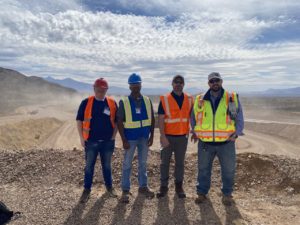
Site 17 – the inner sanctum
Site 17 is in many ways Caterpillar’s inner sanctum of open pit machine testing – with a set of haul roads, loading and dumping areas, berms and ramps that took over eight months to create, it is separated from the rest of the Tucson Proving Ground. It is also staffed by a dedicated team of engineers, mechanics, instrument techs and operators based there in a remote command centre and primarily working on validation of new updates for Command for hauling functionality and machine models.
When IM visited the team was conducting endurance testing on the latest Command for hauling release, which includes increased integration and functionality within MineStar™ when it comes to managing trucks to the crusher and executing a mine plan. The enhanced crusher functionality and integration mean MineStar sends information from its system to the processing control system and receives dynamic change requests to crusher feeds. This will help maximise the efficiency of both the crusher itself and the truck cycles, as MineStar and the plant controller will receive relevant trucking and processing information when required. On the mine plan, the system is now advanced enough to ingest the shift production requirements including the material volumes from each available loading face needed to deliver against plan and the truck assignments that are then prioritised against these targets. So, it is not just about maximising tonnes anymore, it is about the best way to meet the mine plan and responding to varying constraints that may challenge shift by shift conformance to plan. Caterpillar is bringing MineStar closer to enabling a true mining factory by configuring the outcomes required in the language of the mine, automating the decision-making process, and reducing the workload of the mine controller using MineStar.
The Site 17 location sees Command for hauling development across all Cat’s major mining truck lines
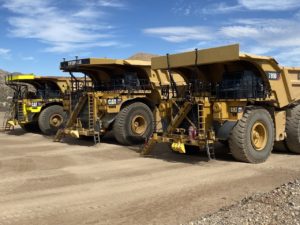
Jarrod Moss stated: “The Tucson Proving Ground is one of several Caterpillar test and validations sites around the world – but it is the largest, and the one most focused on mining equipment based on its geographical scale and fleet of test machines which enable replication of the mining customer’s experience. It also helps to maintain Cat’s brand quality as well as being part of the Caterpillar new product introduction (NPI) process, helping validate new designs and making sure everything meets customer expectations before field follow testing. The testing covers both conventionally operated and autonomous mining equipment, with zero emissions truck testing of course on the horizon. The site has been operating for 30 years now – opening in 1990, but Caterpillar’s Arizona test work actually goes back as far as 1945 when it was taking place in the Phoenix area. Tucson Proving Ground also partners with the adjacent Tinaja Hills Demonstration and Learning Centre, where customers are normally taken to see machines put through their paces.”
And why Site 17? Moss added: “Despite it conjuring up images of a secret ‘Area 51’ type facility, the reason for the naming is actually quite mundane. The State and local County gridded out the Caterpillar property; and the area chosen to do the autonomous testing just happened to be on Site 17 in the grid and was not given any special name. There is a named road called the Level Loop that runs through both Site 17 and 18 which as its name suggests is completely level and allows for some of the testing that is required. This one-mile stretch is useful for high-speed testing, as an example.”
In terms of actual testing, there is a controlled gate at the entrance to the testing area, which requires an individual be fully trained before entering the autonomous operating zone (AOZ) and be equipped with the proper MineStar equipment. As well as the level loop, there are grade hauls, loading and dumping areas just as in a real mine. So, it allows for full cycle testing. Vance adds: “In terms of machine speed for autonomous trucks, there are various ways of managing it. You can put a maximum speed restriction zone across a whole mine site or only in one particular area. The customer has the ability with Command for hauling to manage their truck speed as they wish. For example, putting speed limits in dust prone road sections or traction zones on ramps where you know traction is more difficult which manages speed, deceleration, acceleration, and following distances.”
Samaraweera comments: “Overall, Command for hauling customers tend to have higher average and consistent speeds because MineStar is the best operator on a site. That means higher productivity, with speeds on the autonomous trucks only limited operating within in the safety parameters of existing site conditions and their mechanical or electric drive capabilities. Command for hauling can also today monitor tyre temperatures and will slow down trucks to prevent tyres overheating based on a threshold that the customer can adjust.”
So what checks and balances do the new software versions for Command for hauling go through? First, a development stage tests the new capabilities and content in a general sense to see if it works. Next is a regression stage, where the team makes certain that the new release still meets all the core safety parameters with the new changes included. For these first two stages, a check driver remains in the truck with the ability to assume operational control if there are any issues. This is followed by endurance testing, with no one in the cab to run as many hours and cycles as possible to identify any issues that might come up under normal operations. Once the first customer receives the new software release, then there is first field follow testing. Only then does it become available to all Command for hauling customers. Prior to all this, the software runs through Caterpillar’s hardware in the loop, software in the loop, and tested on scaled down autonomous machines such as on SUVs before heading to Tucson Proving Ground for further testing.
Paul Moore, IM Editorial Director was given exclusive access to Site 17 at the Tucson Proving Ground
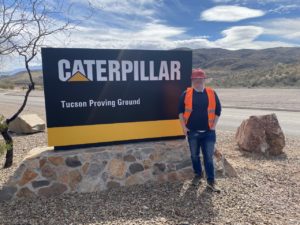
Is there any difference to automation for a mechanical drive truck to an electric drive truck? All the autonomy related hardware – controls like steering and sensors including LiDAR, radar, cameras, etc – are the same. The base machine control area is where there are some differences. The interface asks the truck for speed in a slightly different way, with the speed controller tuned slightly differently for electric drive. Overall, the advantages of one over the other stay the same whether autonomously operated or not. The truck, whether mechanical or electric drive, is tuned to deliver the right speed for approaching a grade, when on grade, as well as when handling curves. Anti-lock braking also provides much better controllability. What about fitting trucks with autonomy on site? If it is a factory-delivered Command-ready truck, then retrofitting can be done in a matter of days because the base machine interface is all ready to go. The process of retrofitting a standard truck is longer.
Typically, at the Tucson Proving Ground, operators stay in the autonomous trucks during validation testing of Command for hauling software updates, as opposed to what informally is referred to as Operator Out Of The Truck (OOOT). Godfryt told IM: “New software is sent to Tucson Proving Ground daily/weekly, so our team is always testing various stages of software We have to ensure all the core truck and safety features work every time we do a software update. Once we get later in the milestone stage, before release to the customer, we go through regression and endurance testing. Regression means going through everything from the basic MineStar functionality testing on the truck to the latest features we are releasing. Once we are satisfied with the results, the endurance phase then involves running a Command for hauling truck for an established amount of time based on the content testing. Lasting multiple days, we run the truck through cycles of loading, dumping and interaction with other equipment in as close to a real mine scenario as we can get, so we can find any issues before new software releases go out.”
Of course, one of the most significant innovations developed at the site in recent years was the autonomous water truck, now in service at Rio Tinto’s Gudai Darri iron ore mine. The team took a 789D, the 789D being a truck platform which Caterpillar had already automated at the facility. It is able to spray water automatically and be dispatched to the water fill location autonomously. It only delivers the amount of water required at the site, and at exactly the right time and in the right places, reducing traction events from overwatering. It works closely with the main autonomous truck fleet for greater efficiency and safety, without a water truck operator on-board. So what machine is next? The answer is whatever the customer wants – and that is what led to the water truck project in the first place. Following the existing 793F, 793F Tier 4, 797F, 794 and 789D next will come the 785, to be used first at Ioneer’s Rhyolite Ridge project. The autonomous 798, 797F Tier 4 and remaining models are also in the works. And of course, the zero emissions battery trucks, will also be autonomous. MineStar will integrate with the Battery Management System (BMS) to optimise production, maximize battery truck performance, getting the most out of the all-electric truck fleet.
Then and now
Godfryt has worked at the Proving Ground for over ten years. How does Command for hauling differ today from then? “Back then you could load material and then dump it in a set paddock stockpile. A major development nine years ago was inclusion of highwall dumping or edge dumping, so when the truck backs up to the edge, it finds the berm and touches it safely, so it can autonomously dump over it. Since then, we have evolved the system to cover crusher dumps, dozer managed dump areas plus many more features and many more safety controls. It’s like night and day.”
Everything that goes into the autonomous mine site must have some kind of tracking onboard technology, which is referred to as Cat Detect. Every dozer, light vehicle, pick-up, loader, etc – everything is communicating with MineStar. The AHS trucks know the heading and velocity of machines around it, becoming more of a defensive driver around manually driven machines.
Paul Moore and Jag Samaraweera at the Cat MineStar Command Center beside the Tinaja Hills Demonstration Area
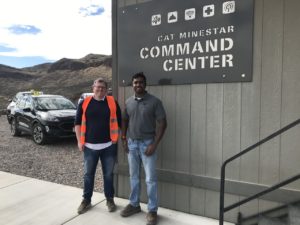
Jag Samaraweera and Michael Vance have been involved with Command for hauling since the first tests at a customer site – the Navajo coal mine in New Mexico. Samaraweera also highlighted the evolution of sensors being used. “Cat started off with a commercially available LiDAR, but ruggedised it for the harsh conditions of mining and adapted it for 24/7 operations. Now referred to as Cat LiDAR, with Cat having IP associated with it, the truck constantly scans the face and the operations team member can automatically update the load and dump plans when required. During the early days, a light vehicle had to survey the toe line and manually adjust the survey by the operations team member prior to production restarting. Today’s software allows survey updates to be done on the fly without stopping production.”
Autonomy and zero emissions trucks
Samaraweera also talked about the importance of autonomy in Caterpillar’s journey towards zero emissions mining trucks – with the first battery trucks planned for rollout at multiple customer sites before 2030. “Command will play a key role in managing battery trucks. With diesel trucks, MineStar can assign the truck to the fuel bay, ‘once you’re at 20% fuel level you need to go to the fuel bay.’ With battery trucks you will need to know the battery level, and at a set point send the truck to charge or adjust its route to charge its battery so it always has enough power to complete its haul cycle. Autonomy is a crucial part of the journey of getting to battery electric – in many ways the best route will be to start with a good foundation of running autonomy as is, then the transition to battery will be a lot easier. It will also make the change management a lot smoother. As many operations migrate toward autonomy and fleet electrification we believe the combination of autonomy, connectivity, and electrification, when knit together, provides customers the safest and most productive sites.”
Back to Command for hauling, what has been learned about introduction of the system to new customers? Vance stated: “We learned that the best option is to apply autonomy in a small, isolated area first, with one or two trucks, then start cycling the rest of the operation through that area so that they feel comfortable with autonomy. They can see how the truck stops, how do you refuel a truck, how do you get the truck into maintenance? Then the change management element becomes much easier, and you quickly expand the scale of the autonomous operation from there.”
And what about teleremote operated shovels? Today the shovel operator in the pit manages the autonomous trucks as they come into the loading area and then leave after being loaded. Godfryt comments: “It will be similar because all the shovel controls are tied into the Terrain system on the panel; or you can use the panel to call in autonomous trucks, so it will be no different really. The truck won’t leave its set parameters – today we can already load on the blind side of the truck.” Caterpillar has the technology to move the shovel operator remote but believe providing operator assist functionality is the better route in the near term.
Evolving autonomy solutions
Vance also talked about the industry desire for a ‘lighter weight’ autonomy solution for some mine sites. “At one end of the spectrum, you have Command for hauling that is tech heavy, with high-end sensors like LiDAR. At the other end you have smaller sites which require a less tech heavy solution to get similar functionality on sites with less infrastructure, for example, relying more on cameras and being able to bring in the latest technology from automotive. The two will converge somewhat and the solution will really depend on the individual customer site – based on the need and the application. Command for hauling didn’t get where it is by accident – the big mines need the extra functionality and capability that it has – but other mines may not.”
What about other new Command for hauling functionalities that are being developed? Vance states: “We are working to add more automation to the process to make the trucks smarter. Today we are in the final testing stages of technology that is camera based – the camera allows the operations team to see what the obstacle is so if it is something like a contractor vehicle that happens to not be MineStar connected and shouldn’t be in that area, then they can intervene. The technical challenge is merging the camera image with the LiDAR image, but we have done this.”
On the largest Command for hauling sites, there are over 70 autonomous trucks and over 300 other vehicles including light vehicles, water trucks, graders, dozers, wheel loaders and even other non-autonomous rigid trucks. All those vehicles are on MineStar and have a radio transmitter, high-precision GPS and a display. The operators of those vehicles must know where the autonomous trucks are – on an autonomous site, the autonomous trucks have the right of way and the manned machine operators can see where they are. Blue lanes denote active autonomous truck routes where those trucks own that lane. Green is just a lane that exists in the mine model, and yellow means the autonomous truck has been assigned there but doesn’t yet have permission. These colour codings are very useful at intersections so manned vehicle operators know if they can go or wait for the autonomous truck to go past.
Autonomy for the smaller class machines
The market for application of autonomy onto quarry class and smaller mining class machines has picked up pace recently with progress from the likes of SafeAI, indurad, Auto-mate and others. But it is a space where Caterpillar also has big plans and IM was also able to catch up with Joe Forcash at the Proving Ground who is heading up this project.
In June 2020, Caterpillar acquired select assets and hired employees from Marble Robot, Inc., a San Francisco, California based robot and autonomy technology solutions company. The acquisition was part of the company’s automation and autonomy strategy to meet the needs of smaller mines as well as the construction and quarrying, plus industrial and waste industries. The first machine to be equipped with the new autonomy system is a Cat 299D3 Compact Track Loader (CTL), based on a first customer in solar power. The CTL delivers solar panels into position. At a typical solar farm during the construction phase, there are solar modules and other components that need delivering across a large area.
Caterpillar takes the customer site design files and develops available routes for autonomy, which are then integrated with a tablet which is in wireless communication with the CTL. Using remote control, the operator can pick up a pallet then tell the CTL where it wants it delivered on the map, switching to autonomous mode in which the CTL can deliver and return with no interaction and no further network input needed as it has all the necessary information onboard. With this technology, one operator can manage up to four CTLs at the solar farm site.
Forcash stated: “It’s a nice introduction to a smaller machine – and is applicable to ancillary machines in mining but right now is focussed on a semi-autonomous, remote control solution for a solar farm site which is very isolated, where you have no network access. Over time we intend to integrate the technology into MineStar so you would have the ability to control it via a Command station. It is similar to what we have today with our semi-autonomous tractor system for our crawler dozers plus Command suite solutions for small wheel loaders and excavators that are already being used in port material handling.”
What about its evolution up into larger wheel loaders, articulated dump trucks and other non-mining-class equipment? “Right now we are supporting customers at two ends of the spectrum – we have light construction, exemplified by the CTL, and Command for Hauling for large miners. Our engineers are working toward leveraging our capabilities at both ends to provide a scalable solution across multiple customer applications,” Forcash continued. “The more repetitive the machine movements the more ready it will be for autonomy. This lighter weight approach to autonomy with the CTL allows Cat to bring autonomy to operations with a different cost structure – quarries and construction sites don’t operate with the same cost approach to big mines. Mines generally have all the network infrastructure already in place, so that every machine on the site can be connected relatively easily. The CTL can run fully autonomous without any network so is a lot easier for a quarry application from a long-term point of view. And where it makes sense, we will also drive the best elements of this technology into mining.”
He adds: “The solution is a combination of three things. First, what we have learned and developed for autonomous mining, including components and some of the software. Second is our Command remote control technology. And third, what we acquired with Marble. Those three pieces have really come together. It has been designed not as a one off but as a technology we can integrate and grow into the Cat product line. Automotive progress has also helped drive down cost in terms of hardware to help us be able to bring these Command solutions to smaller equipment – it would not have been possible even five years ago.”
With a spectrum of autonomous technologies, Caterpillar’s goal is to work with each customer to identify the best solution to meet their safety, productivity, and efficiency goals.











